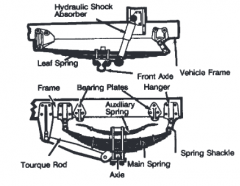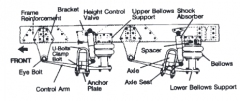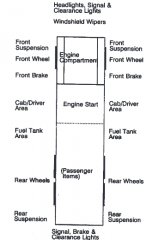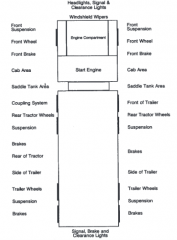![]()
![]()
![]()
Use LEFT and RIGHT arrow keys to navigate between flashcards;
Use UP and DOWN arrow keys to flip the card;
H to show hint;
A reads text to speech;
112 Cards in this Set
- Front
- Back
|
You must have a CDL to operate
|
A single vehicle with a gross vehicle weight rating GVWR of more than 26,000 pounds.
A trailer with a GVWR of more than 10,000 pounds if the gross combination weight rating is more than 26,000 pounds. A vehicle designed to transport more than 15 persons including the driver |
|
|
_________ is the most important reason you inspect your vehicle.
|
safety
|
|
|
Types of Vehicle Inspection
|
pre-trip
during a trip after trip inspection and report |
|
|
You need at least ______ inch tread depth in
every major groove on front tires. You need _____ inch on other tires. |
4/32 2/32
|
|
|
Examples of Steering System Key Parts
|

-Steering Arms/Wheels
-Steering Wheel Shaft - Tie Rod -Steering Gear Box -Pitman Arm -Drag Link -Steering Ring Knuckle -Spindle |
|
|
You must notify your employer within _____ days of conviction for any traffic violations (except parking).
|
30
|
|
|
If an offense occurs while you are operating a CMV that is placarded for hazardous materials, you will lose your CDL for at least ______ years.
|
three
|
|
|
You will lose your CDL for at least ____ year for a first
offense: -drive a CMV under the influence of alcohol or a controlled substance -leave the scene of an accident involving a CMV you were driving. -use a CMV to commit a felony, etc. |
one
|
|
|
You will lose your CDL:
-For at least _____ days if you have committed two serious traffic violations or one violation of a law that regulates the operation of a motor vehicle at a railroad grade crossing within a three-year period involving a CMV. |
60
|
|
|
You will lose your CDL:
-For at least _____ days for three serious traffic violations or two violations of a law that regulates the operation of a motor vehicle at a railroad grade crossing within a three-year period. |
120
|
|
|
“_________ ________ _________” are excessive speeding (15 mph or more above the posted limit), reckless driving, improper or erratic lane changes, following a vehicle too closely, traffic offenses committed in a CMV in connection with fatal traffic accidents, driving a CMV without a CDL, and driving a CMV without a CDL in possession.
|
Serious traffic violations
|
|
|
It is illegal to operate a CMV if your Blood Alcohol Concentration (BAC) is ____% or more.
|
.04
|
|
|
You will lose your CDL for one year for your first offense. You will lose it for ______ for your second offense.
|
life
|
|
|
If your blood alcohol concentration is less than 0.04% but you have any detectable amount, you will be put out-of service for ____ hours.
|
24
|
|
|
________ around wheel nuts may mean the nuts are
loose--check tightness. |
Rust
|
|
|
How do you know if brake drums or shoes are bad?
|
-Cracked drums.
-Shoes or pads with oil, grease, or brake fluid on them. -Shoes worn dangerously thin, missing, or broken. |
|
|
The suspension system holds up the vehicle and its load. It keeps the ________ in place.
|
axles
|
|
|
Missing or broken leaves in any leaf spring. If ___________ or more are missing, it will put the vehicle “out of service” but any defect could be dangerous
|
one-fourth
|
|

-Hydraulic Shock Absorber
-Leaf Spring -Front Axle Hanger -Vehicle Frame -Bearing Plates -Spring Shackle -Tourque Rod -Main Spring -Axle |
Key Suspension Parts
|
|

-Frame reinforcement
-bracket -height control valve -upper bellows support -shock absorber -eye bolt -control arm -anchor plate -axle, axle seat -spacer -lower bellows support |
Air Suspension Parts
|
|
|
A broken ________ _________ can let poison fumes into the cab or sleeper berth.
|
exhaust system
|
|
|
You must make sure the truck is not overloaded and the cargo is ____________ and secured before each trip.
|
balanced
|
|
|
What things should you check during a trip?
|
-Watch gauges for signs of trouble.
-Use your senses to check for problems (look, listen, smell, feel). |
|
|
Name some suspension system defects.
|
-Spring hangers that allow movement of axle from proper position.
-Cracked or broken spring hangers -Leaking shock absorbers |
|
|
What three kinds of emergency equipment must you
have? |
-fire extinguisher
-spare electrical fuses -Warning devices for parked vehicles (for example, three reflective warning triangles) |
|

|

|
|
|
Check that the parking brakes are on and/or wheels
___________. |
chocked
|
|
|
Some things to check under the hood:
|
Engine oil level.
Coolant level in radiator; condition of hoses. Power steering fluid level Windshield washer fluid level. Battery fluid level, connections, and tie downs Automatic transmission fluid level |
|
|
Start Engine and Inspect Inside the Cab
|
-Make sure parking brake is on.
-Put gearshift in neutral (or “park,” if automatic). -Start engine; listen for unusual noises |
|
|
Which gauges should you look at?
|
-Oil pressure
-Ammeter and/or voltmeter. -Coolant temperature. -Engine oil temperature. -Warning lights and buzzers |
|
|
Check all of the following for looseness, sticking, damage, or improper setting:
|
Steering wheel.
Clutch. Accelerator (“gas pedal”). Brake controls. -Foot brake. -Trailer brake (if vehicle has one). -Parking brake. -Retarder controls (if vehicle has them). Transmission controls. Interaxle differential lock (if vehicle has one). Horn(s). Windshield wiper/washer. Lights |
|
|
How do you check your lights?
|
Make sure the parking brake is set, turn off the engine, and take the key with you. Turn on headlights (low beams) and four-way flashers, and get out.
|
|
|
If the vehicle has hydraulic brakes, pump the brake pedal _______ times. Then apply firm pressure to the pedal and hold for five seconds. The pedal should not move. If it does, there may be a leak or other problem.
|
three
|
|
|
How do you test the parking brake?
|
Fasten seat belt.
Allow vehicle to move forward slowly. Apply parking brake. If it doesn’t stop vehicle, it is faulty; get it fixed |
|
|
how do you Test Service Brake Stopping Action?
|
Go about five miles per hour.
-Push brake pedal firmly. -“Pulling” to one side or the other can mean brake trouble. -Any unusual brake pedal “feel” or delayed stopping action can mean trouble. |
|
|
Drivers of trucks and truck tractors when transporting cargo must inspect the securement of the cargo within the first ____ miles of a trip and every 150 miles or every three hours (whichever comes first) afterward.
|
25
|
|
|
Name some things you should check on the front of your vehicle during the walk-around inspection.
|
-Go to front of vehicle and check that low beams are on and both of the four-way flashers are working.
-Push dimmer switch and check that high beams work. -Turn off headlights and four-way, hazard warning flashers. -Turn on parking, clearance, side-marker, and identification lights. -Turn on right turn signal, and start walk-around inspection. |
|
|
What should wheel bearing seals be checked for?
|
leakage
|
|
|
How many red reflective triangles should you carry?
|
3
|
|
|
Why put the starter switch key in your pocket during the pre-trip inspection?
|
someone might move the vehicle while you are checking underneath it.
|
|
|
Safe operation of a commercial vehicle requires skill in:
|
-Accelerating.
-Steering. -Shifting gears. -Braking. |
|
|
Partly engage the clutch _________ you take your right foot off the brake.
|
before
|
|
|
When pulling a trailer, rough acceleration can damage the __________.
|
coupling
|
|
|
If the drive wheels begin to spin, take your foot off the _____________.
|
accelerator
|
|
|
When you park, try to park so you will be able to pull
____________ when you leave. |
forward
|
|
|
Why should you back toward the driver’s side?
|
If you back and turn toward the driver’s side, you can watch the rear of your vehicle by looking out the side window
|
|
|
What is a pull-up?
|
when you pull forward to reposition your vehicle while backing up.
|
|
|
If stopped on a hill, how can you start moving without
rolling back? |
Partly engage the clutch before you take your right foot off the brake. Put on the parking brake whenever necessary to keep from rolling back. Release the parking brake only when you have applied enough engine power to keep from rolling back.
|
|
|
When backing, why is it important to use a helper?
|
There are blind spots you can’t see.
|
|
|
What’s the most important hand signal that you and the helper should agree on?
|
Agree on a signal for “stop.”
|
|
|
When backing a trailer, you turn the steering wheel in the _________ direction.
|
opposite
|
|
|
Most heavy vehicles with manual transmissions require _________ ___________ to change gears.
|
double clutching
|
|
|
Basic Method for Shifting Up
|
1. Release accelerator, push in clutch and shift to neutral at the same time.
2. Release clutch. 3. Let engine and gears slow down to the rpm required for the next gear (this takes practice). 4. Push in clutch and shift to the higher gear at the same time. 5. Release clutch and press accelerator at the same time. |
|
|
There are two ways of knowing when to shift:
|
-Use Engine Speed (rpm).
-Use Road Speed (mph) |
|
|
Some newer vehicles use “____________” shifting: the rpm at which you shift becomes higher as you move up in the gears.
|
progressive
|
|
|
Basic Procedures for Shifting Down
|
1. Release accelerator, push in clutch, and shift to neutral at the same time.
2. Release clutch. 3. Press accelerator, increase engine and gear speed to the rpm required in the lower gear. 4. Push in clutch and shift to lower gear at the same time. 5. Release clutch and press accelerator at the same time. |
|
|
Downshift __________ starting down the hill
|
before
|
|
|
_______________ rear axles and auxiliary transmissions are used on many vehicles to provide extra gears.
|
Multi-speed
|
|
|
Some vehicles have ______________ transmissions.
|
automatic
|
|
|
The lower ranges prevent the transmission from shifting up beyond the selected gear unless the governor (rpm) is ___________.
|
exceeded
|
|
|
Some vehicles have “___________”.
|
retarders.
|
|
|
What do Retarders do?
|
help slow a vehicle, reducing the need for using your brakes
|
|
|
What are the two special conditions where you should
downshift? |
going downhill & on curves
|
|
|
When should you downshift automatic transmissions?
|
when going down grades
|
|
|
When your drive wheels have poor traction, the
retarder may cause them to ______. Therefore, you should turn the retarder off whenever the road is wet, icy, or, snow covered. |
skid
|
|
|
Most good drivers look _____ to _____ seconds ahead.
|
12 to 15
|
|
|
At highway speeds 12 to 15 seconds is about a _______ of a mile.
|
quarter
|
|
|
At lower speeds, 12 to 15 seconds is about ____ block.
|
one
|
|
|
three good rules for using turn signals
|
-Signal early
-Signal continuously -Cancel your signal. |
|
|
Warn other drivers in any of the following situations:
|
-Trouble Ahead
-Tight Turns -Stopping on the Road -Driving Slowly -Don’t Direct Traffic |
|
|
When you pull off the road and stop, be sure to turn on the ________ _________ ___________.
|
four-way emergency flashers
|
|
|
What’s your most important way to see the sides and
rear? |
mirrors
|
|
|
What does “communicating” mean in safe driving?
|
-Signal Your Intentions
-Communicating Your Presence |
|
|
Where should your reflectors be placed when stopped on a divided highway?
|
10 feet, 100 feet, and 200 feet toward the approaching traffic
|
|
|
What three things add up to total stopping distance?
|
Perception Distance
+ Reaction Distance + Braking Distance |
|
|
If you go twice as fast, will your stopping distance
increase by twice or four times? |
four times
|
|
|
Empty trucks have the best braking. True or False?
|
False
|
|
|
What is hydroplaning?
|
It’s like water skiing: the tires lose their contact with the road and have little or no traction. You may not be able to steer or brake. You can regain control by releasing the accelerator and pushing in the clutch.
|
|
|
What is “black ice?”
|
a thin layer that is clear enough that you can see the road underneath it. It makes the road look wet.
|
|
|
One good rule says you need at least one second for each ____ feet of vehicle length at speeds below 40 mph.
|
10
|
|
|
If you are driving a 30-foot vehicle at 55 mph, how many seconds of following distance should you allow?
|
4 seconds
|
|
|
You should decrease your following distance if somebody is following you too closely. True or False?
|
False you should increase your following distance to avoid making sudden speed changes.
|
|
|
If you swing wide to the left before turning right, another driver may try to pass you on the right. True or False?
|
True
|
|
|
You should use low beams whenever you can. True or
False? |
True
|
|
|
What should you do before you drive if you are drowsy?
|
get off the road and get some sleep.
|
|
|
What effects can wet brakes cause? How can you avoid these problems?
|
-Water in the brakes can cause the brakes to be weak, to apply unevenly, or to grab.
-Avoid driving through deep puddles or flowing water if possible. |
|
|
You should let air out of hot tires so the pressure goes
back to normal. True or False? |
False
|
|
|
You can safely remove the radiator cap as long as the
engine isn’t overheated. True or False? |
true
|
|
|
What factors determine your selection of a “safe” speed when going down a long, steep downgrade?
|
-Total weight of the vehicle and cargo.
-Length of the grade. -Steepness of the grade. -Road conditions. -Weather. |
|
|
Why should you be in the proper gear before starting
down a hill? |
You will not be able to shift into a lower gear. You may not even be able to get back into any gear and all
engine braking effect will be lost. |
|
|
Describe the proper braking technique when going down a long, steep downgrade
|
1. Apply the brakes just hard enough to feel a definite slowdown.
2. When your speed has been reduced to approximately five mph below your “safe” speed, release the brakes. [This brake application should last for about three seconds.] 3. When your speed has increased to your “safe” speed, repeat steps 1 and 2. |
|
|
What is a hazard?
|
any road condition or other road user (driver, bicyclist, pedestrian) that is a possible danger.
|
|
|
Why make emergency plans when you see a hazard?
|
Seeing this hazard gives you time to check your mirrors and signal a lane change. Being prepared reduces the danger.
|
|
|
What are some things to do at an accident scene to prevent another accident?
|
-Protect the area.
-Notify authorities. -Care for the injured |
|
|
Name two causes of tire fires
|
Under-inflated tires and duals that touch
|
|
|
What kinds of fires is a B:C extinguisher good for?
|
electrical fires and burning liquid
|
|
|
When using your extinguisher, should you get as close as possible to the fire?
|
no, stay as far away as possible
|
|
|
Name some causes of vehicle fires
|
-After Accidents
-Electrical System -Fuel -Cargo |
|
|
Common medicines for colds can make you sleepy. True or False?
|
True
|
|
|
What should you do if you do become sleepy while driving?
|
Stop to sleep
|
|
|
Coffee and a little fresh air will help a drinker sober up. True or False?
|
false
|
|
|
What is a hazardous materials placard?
|
They are 10-3/4 inches square, turned upright on a point, in a diamond shape.
|
|
|
Why are placards used?
|
signs put on the outside of a vehicle which identify the hazard class of the cargo.
|
|
|
For what three things related to cargo are drivers responsible?
|
-Inspecting your cargo.
-Recognizing overloads and poorly balanced weight. -Knowing if your cargo is properly secured |
|
|
How often must you stop while on the road to check your cargo?
|
Every 3 hrs/150 miles
|
|
|
How is GrossCombinationWeightRating different from
GrossCombinationWeight? |
-Gross Combination Weight (GCW). The total weight of a powered unit plus trailers plus the cargo.
-Gross Combination Weight Rating (GCWR). The maximum GCW specified by the manufacturer for a specific combination of vehicles plus its load. |
|
|
Name two situations where legal maximum weights may not be safe.
|
During bad weather or in mountains
|
|
|
What can happen if you don’t have enough weight on the front axle?
|
Too little weight on the driving axles can cause poor traction
|
|
|
What is the minimum number of tiedowns for any flatbed load?
|
Cargo should have at least one tiedown for each 10 feet of cargo. No matter how small the cargo, it should have at least two tiedowns holding it.
|
|
|
What is the minimum number of tiedowns for a 20 ft.
load? |
2
|
|
|
Name the two basic reasons for covering cargo on an
open bed. |
(1) to protect people from spilled cargo, and (2) to protect the cargo from weather
|
|
|
What must you check before transporting a sealed load?
|
check that you don’t exceed gross weight and axle weight limits
|

